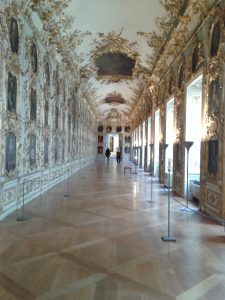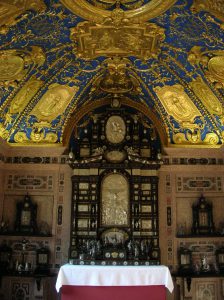The Munich Residence and the Treasury
By Tracy A. Burns
History of the Residence
 Enter the palace of the Munich Residence, the former home of Bavarian rulers from the House of Wittelsbach, and you are sure to be dazzled by the rich furnishings, paintings, sculpture, tapestries, bronzes and porcelain in architecturally fascinating rooms. The complex includes buildings of various styles and has 10 courtyards. The Residence hails from 1385 when the castle Neuveste was constructed on the site. The palace was badly damaged during World War II, and reconstruction was not near completion until the 1980s.
Enter the palace of the Munich Residence, the former home of Bavarian rulers from the House of Wittelsbach, and you are sure to be dazzled by the rich furnishings, paintings, sculpture, tapestries, bronzes and porcelain in architecturally fascinating rooms. The complex includes buildings of various styles and has 10 courtyards. The Residence hails from 1385 when the castle Neuveste was constructed on the site. The palace was badly damaged during World War II, and reconstruction was not near completion until the 1980s.
The Grotto Hall
Be sure to take the long route, so you don’t skip the Trier Rooms. At the beginning of the tour, the barrel-vaulted hall designed as a grotto will amaze with its stalactite and stalagmite shapes set with colorful shells and crystals. Sea monster, bird, and flower vase motifs decorate the hall also adorned with human and animal figures. Paintings of the gods of Olympus also enthrall.
The Hall of Antiquities
The 70-meter-long Hall of Antiquities, constructed from 1568 to 1571, is the largest Renaissance hall north of the Alps. Grotesque ceiling paintings of beasts and 102 vedute and landscapes of Bavarian towns, markets, and castles add to the grandeur of the vast space. The sculpture is a highlight, too, with 270 works from antiquity and the Renaissance as well as from the 18th and 19th centuries. Busts of Roman emperors from Julius Caesar to Domitian make appearances.
The Ornate Chapel
 Consecrated in 1607, the Ornate Chapel is unique with its scagliola wall paneling. A technique for creating architectural features that appear to be inlays and semi-precious stones, scagliola is made from selenite, glue and natural pigments. Scagliola pictures narrate 10 scenes from the Life of the Virgin Mary after Albrecht Dürer. Gilt reliefs and a 12-tiered ebony altar from 1605 adorn the space. Don’t forget to look up. The blue-and-gold domed ceiling is sure to fascinate.
Consecrated in 1607, the Ornate Chapel is unique with its scagliola wall paneling. A technique for creating architectural features that appear to be inlays and semi-precious stones, scagliola is made from selenite, glue and natural pigments. Scagliola pictures narrate 10 scenes from the Life of the Virgin Mary after Albrecht Dürer. Gilt reliefs and a 12-tiered ebony altar from 1605 adorn the space. Don’t forget to look up. The blue-and-gold domed ceiling is sure to fascinate.
The Stone Rooms and the Trier Rooms
The Stone Rooms and the Trier Rooms feature exquisite tapestries. In the Stone Room, the tapestries narrate scenes from the life of Bavarian duke Otto I, who established the Wittelsbach dynasty. The largest rooms in the palace, feature marble, stucco marble, and scagliola with imitation marble inlay. In the Trier Rooms, the tapestries take up the theme of the months of the year. January shows a court dwarf entertaining at a banquet. People from all walks of life are pictured in the 17th-century works. Wooden coffered ceilings also amaze. Take a look at the ceiling painting in the Room of Counsel, where a mirror has three faces depicting the past, present, and future.
Other significant rooms
The Green Gallery, named after a green wall covering made of silk damask, boasts superb paintings. The Cabinet of Miniatures includes 129 paintings and is gold with wine red lacquer walls. The Papal Rooms boast Baroque décor while the Ancestral Gallery and Porcelain Cabinet flourish in Rococo style. The Charlotte Rooms, the Royal Apartments, and the Halls of Battles represent the Neo-Classical style. The ceiling paintings in the Nibelungen Halls are not to be overlooked, either.
The Ancestral Gallery
The tour ends with the Ancestral Gallery, decorated with portraits of over 100 members of the Wittelsbach dynasty and their consorts on carved, gilded wall paneling. This is south German Rococo style at its best.
The Treasury
The 10 halls of the Treasury show off works from the Middle Ages to Neo-Classicism. It features a 1597 gold statuette of St. George dressed as a knight. Take a look at all those gems. A gold cup is adorned with 36 blue sapphires in the Bavarian national colors. Emperor Charles the Bald’s prayer book dates from 860. Royal crowns are also on display, including an English Queen’s Crown from 1370 and the Crown of Bavaria from 1807. Visitors can also admire sacred vestments, monstrances, and reliquaries.
The East Asian Collection and Coin Collection
The East Asian Collection features 500 pieces of porcelain and numerous paintings. The Coin Collection includes more than 300,000 coins, including some from ancient Greece. Medals, insignia, and banknotes are displayed, too.
The Cuvilliés Theatre
Nearby is the lavish, horseshoe-shaped, Rococo-style Cuvilliés Theatre, designed by Belgian-born Bavarian architect François de Cuvilliés and built from 1751 to 1753. The former royal theatre of the palace, the Cuvilliés Theatre boasts carved and gilded boxes. Red and gold décor adds to its elegance. Four floors each have 14 loges. Mozart’s Idomeneo premiered here in 1781, and the first production of Ibsen’s Hedda Gabler took place here in 1891.



